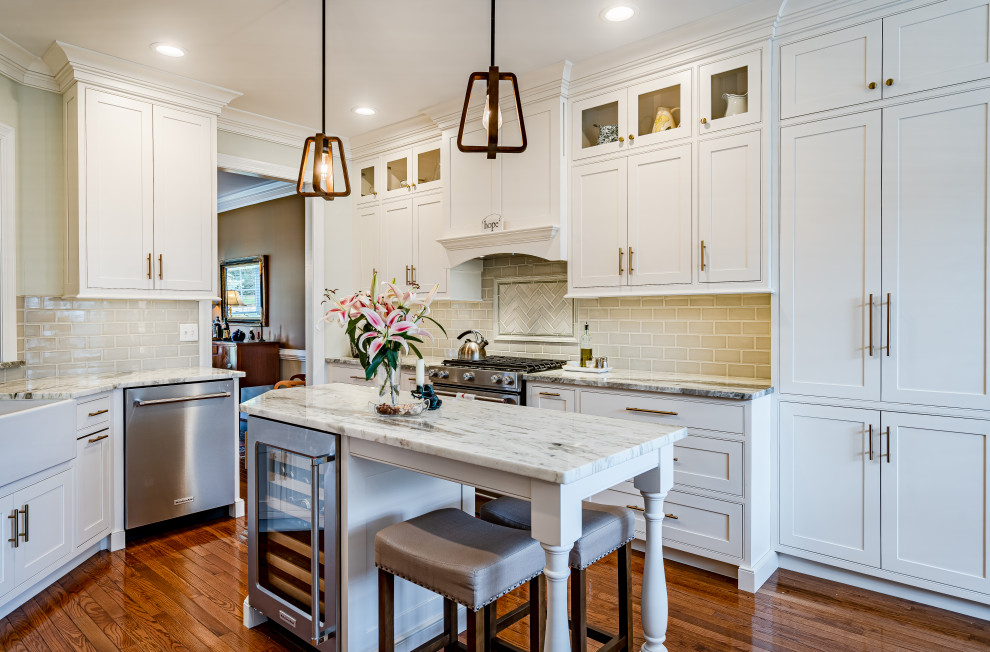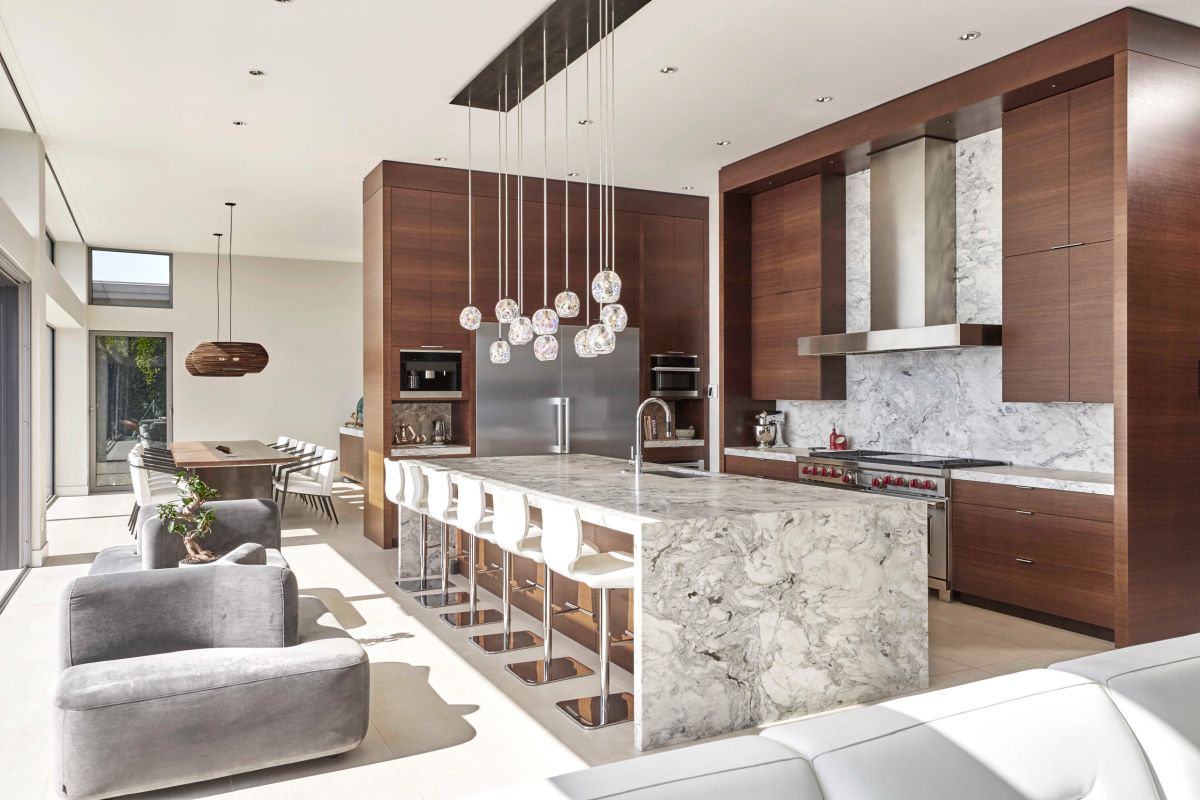Dolomite countertops are not nearly as common as natural stones like quartzite, marble, or granite. But, they’re rising in popularity as a durable and affordable marble look alike.
Dolomite might be the perfect fit if you’re after the white and gray countertop look. It’s beautiful, widely abundant, more scratch-resistant than marble, and an excellent choice for kitchens and bathrooms.
If you’re considering a dolomite countertop for your project, here’s what to expect.
What are Dolomite Countertops?
Dolomite is a sedimentary rock that forms on the earth’s surface. It’s similar to limestone and is usually white or light gray. Dolomite typically has gray or beige veining but can sometimes have hints of pink, black, brown, or green.
Dolomite, also known as dolostone or dolomite stone, is abundant all over the world. Since the dolomite rock is so durable it’s great for use as kitchen countertop materials.
It’s mined and cut into high polished slabs.
While Dolomite looks similar to marble or quartzite, its hardness falls between them.
Is Dolomite Scratch and Heat Resistant?
Dolomite countertops are somewhat scratch resistant – it falls between marble and granite. So while it won’t scratch easily, it will scratch if you run a sharp piece of glass or knife over it.
Because of this, you should never cut on dolomite counters without using a cutting board.
Dolomite is heat resistant. You won’t have to worry about hot pots or cups of coffee ruining it. But even though dolomite has heat resistance, you still shouldn’t put hot pans directly on it.
How Often Do You Need to Seal Dolomite Countertops?
Like other natural stones, dolomite is porous, which means it absorbs liquid. Because of the porosity of dolomite, you’ll need to seal it on an annual basis.
A coat of sealant will impregnate the stone, causing it to repel liquids rather than absorb them.
How Do You Clean Dolomite Counters?
To clean your dolomite countertops, use a ph neutral cleaner. You can use a cleaner specifically for stone or a simple dish soap and water mixture.
Never use acidic cleaners on dolomite kitchen countertops. These include anything with vinegar, lemon juice, or ammonia. Acidic cleaners will eat through your countertop’s sealant and etch the stone.
How Much Do Dolomite Counters Cost?
You may have heard that dolomite is a lower-cost, more durable marble alternative – which is half true.
On average, dolomite costs around $60 per square foot. Depending on your location and the specific stone you choose, this price may be more or less. The average installation cost for a 30 sq ft counter is approximately $600.
So, for a 30 sq ft counter, the total cost will run an average of $2,400.
At this price, the cost of dolomite countertops is the same price range as marble.
Pros and Cons of Dolomite Countertops
If you’re considering adding dolomite to your kitchen, here’s a quick run down of the pros and cons:
Pros of dolomite countertops:
- Long-lasting
- High-end look
- All slabs are one of a kind
- Heat resistant
- Durable
- Easy to care for
Dolomite countertop cons:
- Not completely scratch resistant
- Must seal annually
- Will stain if not regularly sealed
- Must use gentle cleaners
Dolomite Countertop Examples
If you’re wondering if dolomite countertops will look good in your space, here are some examples of how others have used this beautiful stone countertop.
Gray and White Countertops and Backsplash in the Kitchen

If you’re going for a high-end look, consider using dolomite as your kitchen countertop and backsplash. The veining in these gray and white countertops looks stunning paired with the emerald green cabinets and polished gold accents the designer chose.
You can pair this look with any color cabinet, including white or wood.
Fantasy Brown Dolomite with White Cabinets

Fantasy Brown dolomite countertops are growing in popularity for their beautiful veining. If you love fantasy brown, you can find it in dolomite.
As witnessed in this kitchen, Fantasy Brown dolomite works well with white and blue-gray cabinets.
White Dolomite in a Traditional Kitchen

Like marble, dolomite works for almost all kitchen styles. This kitchen has slightly more traditional cabinets and fixtures, and the Latte Macchiato Dolomite kitchen countertop suits it perfectly.
You could use beautiful veiny dolomite on your island with white counters elsewhere or use it throughout your kitchen.
Gray Dolomite in an Earthy Kitchen

Consider a mostly gray slab if you’re not interested in the standard white dolomite or marble look.
The soft gray dolomite in this kitchen has a little beige and white running through it, giving it the perfect earthy feel. It coordinates beautifully with the wood cabinets and white island.
High-End Kitchen with Dolomite

Dolomite is a more durable marble alternative that looks stunning on waterfall islands. In this kitchen, dolomite is used liberally – on the counters, island, and backsplash.
The result is a high-end yet modern-looking kitchen.
Dolomite vs. Quartz
Dolomite is a natural stone that forms on the earth’s surface.
Quartz is an engineered stone. It’s about 90% quartz material bound in a mixture of pigments and resin.
Quartz countertops are non-porous, meaning they won’t stain, and you don’t have to seal them. On the other hand, dolomite is a porous stone you’ll need to seal annually.
Both are durable countertop solutions.
- Appearance: Quartz comes in many color options and resembles natural stone. Dolomite is the way to go for an organic look. It has veining that resembles marble, and each slab is one of a kind.
- Maintenance: Quartz is zero maintenance. Dolomite requires a little care, and you’ll need to seal it annually.
- Cost: The average cost of material and installation for a 30 sq ft dolomite counter is $2,400. The price of a quartz counter the same size is approximately $3,750.
Dolomite vs. Marble
Dolomite counters resemble marble. These two get mistaken for one another even by experienced designers.
Both marble and dolomite have beautiful veining and are predominantly white or gray.
The most significant difference between the two is that marble is a soft stone. As a result, marble is more susceptible to stains, scratches, and etching.
- Appearance: Similar. These two stones are hard to tell apart.
- Maintenance: You’ll need to seal dolomite annually. Depending on the type, you’ll need to seal marble every 3-12 months.
- Cost: The average cost of material and installation for a 30 sq ft dolomite counter is $2,400. For marble, the average price is $2,150.
Dolomite vs. Granite
Granite is hard to beat if you’re looking for a durable stone. It’s excellent at resisting scratches, can hold up to heat, and doesn’t need as much care as comparable countertops.
While dolomite is also durable, it’s not as hard as granite.
But the most significant difference between the two is their looks. Dolomite looks like marble. On the other hand, granite comes in many colors and is usually speckled.
- Appearance: Dolomite has marble-like veins while granite is speckled. You can find granite in many more color options.
- Maintenance: You need to seal dolomite annually. With granite, you may be able to seal only every 1 to 5 years.
- Cost: The average cost of material and installation for a 30 sq ft dolomite counter is $2,400. The average price of 30 sq ft granite countertops is $2,100.
Frequently Asked Questions (FAQ)FAQ
Is dolomite a quartzite or a marble?
Dolomite rock is neither quartzite nor marble. Instead, it’s a sedimentary rock similar to limestone. Dolomite looks like marble but is harder and more scratch-resistant. Dolomite is not as rugged or durable as a quartzite countertop.
Is dolomite or quartzite more expensive?
Quartzite is more expensive than dolomite. For example, the average price of a 30 sq ft dolomite countertop (material and installation) is $2,400 versus $3,950 for quartzite. These prices can vary greatly depending on the specific type of stone and retailer.
Is dolomite hard to maintain?
While not maintenance-free, dolomite is not hard to maintain. If you have dolomite kitchen countertops, you should clean them daily with a gentle ph-neutral cleaner. You’ll also need to seal your counters annually.
Final Thoughts
Dolomite could be a better alternative if you’re considering marble countertops for your kitchen. While these two stones look almost identical, dolomite is harder and less likely to scratch or stain. Dolomite is similar in price to marble countertops.
Two other stone counter options that look similar include quartz and quartzite. These counters are even more durable than dolomite but come with a much higher price tag.
The post Dolomite Countertop Guide: What They Are and How They Stack Up Against Other Options appeared first on Homedit.




